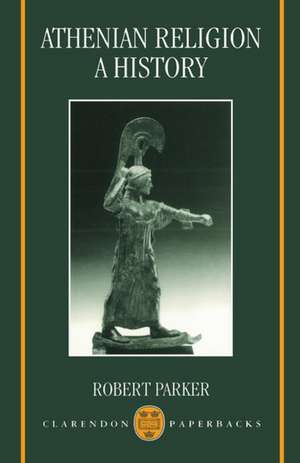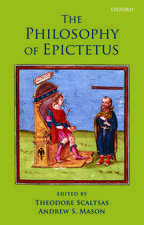Athenian Religion: A History
Robert Parkeren Limba Engleză Paperback – 18 sep 1997
Preț: 439.60 lei
Preț vechi: 562.85 lei
-22% Nou
Puncte Express: 659
Preț estimativ în valută:
84.13€ • 87.51$ • 69.45£
84.13€ • 87.51$ • 69.45£
Carte tipărită la comandă
Livrare economică 03-09 aprilie
Preluare comenzi: 021 569.72.76
Specificații
ISBN-13: 9780198152408
ISBN-10: 019815240X
Pagini: 396
Ilustrații: 3 maps
Dimensiuni: 157 x 234 x 23 mm
Greutate: 0.62 kg
Ediția:Revised
Editura: Clarendon Press
Colecția Clarendon Press
Locul publicării:Oxford, United Kingdom
ISBN-10: 019815240X
Pagini: 396
Ilustrații: 3 maps
Dimensiuni: 157 x 234 x 23 mm
Greutate: 0.62 kg
Ediția:Revised
Editura: Clarendon Press
Colecția Clarendon Press
Locul publicării:Oxford, United Kingdom
Recenzii
What Parker does that is new is to give us a broad picture of religious practices and outlook ... in a single city-state. This ambitious self-limitation permits a developmental account that is refreshingly embedded both in the underlying social framework and in historical narrative. Accordingly, he largely leaves aside the themes usually handled by books on Greek religion. Epigraphists will enjoy seeing their patient reconstructive work rescued from the brilliant obscurity of learned journals to be incorporated into this masterly synthesis. It is an extraordinary achievement to have made the assembling of fragmentary and often unexciting evidence of various kinds, with all the necessary qualification and counter-qualification, so absorbingly readable. Parker excels in elegant caution.
In just the few years in which this book has been on the shelves, it has become the classic study of Athenian religion for the period it deals with.
It is a masterly survey of the development of Athenian religion from the beginnings down to the Hellenistic period, elegant, learned and judicious, so that one keenly looks forward to the thematic history which will eventually follow as Part Two.
fine, meticulously reseasrched study of Athenian faith and worship from the Dark Ages to the execution of Philochoros in 262 ... Athenian religion is a prodigious work of scholarship. The reader who wishes to pursue any topic will be guided by complete references in the footnotes, some of which are equivalent to short encyclopedia articles.
Scholars whose primary interests lie in the interaction between politics and religious practice, in particular, will need to pay close attention to what he has to say.
Parker's history of Athenian religion from the early eighth to the early third centuries BCE is truly comprehensive.
CHOICE
Robert Parker has performed an inestimable service in gathering, organizing and interpreting virtually all available information about Athenian religious practice that can be fitted into a chronological framework. He has done this so meticulously and with such good sense that his work will have to be the starting point for future study of almost any Athenian cult...Parker's achievement is stunning.
This is an extremely valuable book, and it is difficult to see how any worthwhile history of Athens in the period c. 1000-c.250 B.C. could now be written without reference to it...it is densely packed with information, and discussion about the information...it is the material so thoroughly collected and presented by P. that will form the basis of future discussion. For this he is owed the highest praise.
You will find a thesaurus of information, not all of it obvious.
Athenian Religion is both interesting and important ... erudite and even-handed in its treatment of opposing viewpoints ... His analysis of inscriptions is often subtle and acute.
Athenian Religion will serve as a scholarly reference book for years to come.
Anyone with the patience to minde the particular treasures of this preliminary project will find it a helpful resource. For the careful reader, Parker has provided a gnerous and detailed road map to some very important epigraphical texts with significant problems flagged and the interpretations of other scholars succinctly evaluated, even when they are in conflict with his own.
A fine book - well ordered, clearly argued, and erudite. ... Since he is alert constantly to the varying amounts and qualities of the evidence, his definite conclusions are the more impressive when they are given. ... The candour of P's style wins the sympathy of the reader. ... P. has brought ilumination to many previously obscure parts of Athenian religion; and his patient exploration of the evidence for political, social, and cultic groupings ... he has greatly improved our knowledge of Attic history. ... This excellent book is warmly greeted.
In just the few years in which this book has been on the shelves, it has become the classic study of Athenian religion for the period it deals with.
It is a masterly survey of the development of Athenian religion from the beginnings down to the Hellenistic period, elegant, learned and judicious, so that one keenly looks forward to the thematic history which will eventually follow as Part Two.
fine, meticulously reseasrched study of Athenian faith and worship from the Dark Ages to the execution of Philochoros in 262 ... Athenian religion is a prodigious work of scholarship. The reader who wishes to pursue any topic will be guided by complete references in the footnotes, some of which are equivalent to short encyclopedia articles.
Scholars whose primary interests lie in the interaction between politics and religious practice, in particular, will need to pay close attention to what he has to say.
Parker's history of Athenian religion from the early eighth to the early third centuries BCE is truly comprehensive.
CHOICE
Robert Parker has performed an inestimable service in gathering, organizing and interpreting virtually all available information about Athenian religious practice that can be fitted into a chronological framework. He has done this so meticulously and with such good sense that his work will have to be the starting point for future study of almost any Athenian cult...Parker's achievement is stunning.
This is an extremely valuable book, and it is difficult to see how any worthwhile history of Athens in the period c. 1000-c.250 B.C. could now be written without reference to it...it is densely packed with information, and discussion about the information...it is the material so thoroughly collected and presented by P. that will form the basis of future discussion. For this he is owed the highest praise.
You will find a thesaurus of information, not all of it obvious.
Athenian Religion is both interesting and important ... erudite and even-handed in its treatment of opposing viewpoints ... His analysis of inscriptions is often subtle and acute.
Athenian Religion will serve as a scholarly reference book for years to come.
Anyone with the patience to minde the particular treasures of this preliminary project will find it a helpful resource. For the careful reader, Parker has provided a gnerous and detailed road map to some very important epigraphical texts with significant problems flagged and the interpretations of other scholars succinctly evaluated, even when they are in conflict with his own.
A fine book - well ordered, clearly argued, and erudite. ... Since he is alert constantly to the varying amounts and qualities of the evidence, his definite conclusions are the more impressive when they are given. ... The candour of P's style wins the sympathy of the reader. ... P. has brought ilumination to many previously obscure parts of Athenian religion; and his patient exploration of the evidence for political, social, and cultic groupings ... he has greatly improved our knowledge of Attic history. ... This excellent book is warmly greeted.












